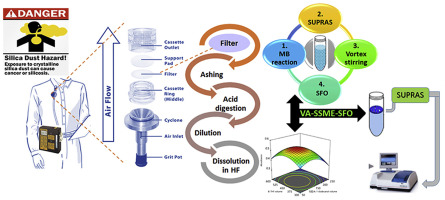当前位置:
X-MOL 学术
›
J. Aerosol Sci.
›
论文详情
Our official English website, www.x-mol.net, welcomes your
feedback! (Note: you will need to create a separate account there.)
A new aerosol into-supramolecular solvent microextraction for spectrophotometric determination of crystalline silica in respirable dust using multivariate optimization
Journal of Aerosol Science ( IF 3.9 ) Pub Date : 2020-04-01 , DOI: 10.1016/j.jaerosci.2019.105511 Amir Najafi , Mahdi Hashemi
Journal of Aerosol Science ( IF 3.9 ) Pub Date : 2020-04-01 , DOI: 10.1016/j.jaerosci.2019.105511 Amir Najafi , Mahdi Hashemi

|
Abstract Inhalation exposure to respirable crystalline silica (RCS) strongly affects human health in many industrial environments. There is a need for sensitive and cost-effective methods for the measurement of hazardous RCS in airborne dust. In this study, for the first time, an optimized separation and preconcentration method was developed based on the aerosol into-supramolecular solvent microextraction system for spectrophotometric determination of RCS in workplaces. The proposed method is based on the collection of the RCS on the PVC filter followed by chemical digestion, silicomolybdenum blue complex formation, and subsequent vortex-assisted supramolecular solvent microextraction using solidification of floating drop for spectrophotometric determination. Furthermore, the response surface methodology was utilized to achieve the optimum conditions for the microextraction procedure. Under the optimized conditions, crystalline silica (α-quartz) can be determined in the linear range of 10.00–400.00 μg L-1 (R2 = 0.9974) with a detection limit (3Sb) of 2.85 μg L-1 and preconcentration factor of 63. Relative standard deviations were less than 3.4% for intra-day precision and less than 4.7% for inter-day precision. The proposed method was successfully applied for the determination of crystalline silica in airborne sample dust and compared with the NIOSH colorimetric standard method. Also, occupational exposure parameters such as time-weighted average for respirable silica and dust concentrations were calculated.
中文翻译:

使用多变量优化分光光度法测定可吸入粉尘中结晶二氧化硅的新型气溶胶转超分子溶剂微萃取
摘要 在许多工业环境中,吸入可吸入结晶二氧化硅 (RCS) 会严重影响人类健康。需要一种灵敏且具有成本效益的方法来测量空气中粉尘中的有害 RCS。本研究首次基于气溶胶转超分子溶剂微萃取系统开发了一种优化的分离和预浓缩方法,用于工作场所RCS的分光光度测定。所提出的方法基于在 PVC 过滤器上收集 RCS,然后进行化学消化、硅钼蓝复合物的形成,以及随后使用浮滴凝固进行分光光度测定的涡流辅助超分子溶剂微萃取。此外,响应面方法用于实现微萃取程序的最佳条件。在优化条件下,结晶二氧化硅(α-石英)的线性范围为 10.00–400.00 μg L-1 (R2 = 0.9974),检测限 (3Sb) 为 2.85 μg L-1,预浓缩因子为 63 . 日内精密度的相对标准偏差小于 3.4%,日间精密度的相对标准偏差小于 4.7%。所提出的方法成功应用于测定空气中样品粉尘中的结晶二氧化硅,并与 NIOSH 比色标准方法进行了比较。此外,还计算了职业暴露参数,例如可吸入二氧化硅和粉尘浓度的时间加权平均值。结晶二氧化硅(α-石英)的线性范围为 10.00–400.00 μg L-1 (R2 = 0.9974),检测限 (3Sb) 为 2.85 μg L-1,预浓缩因子为 63。相对标准偏差为日内精密度低于 3.4%,日间精密度低于 4.7%。所提出的方法成功应用于测定空气中样品粉尘中的结晶二氧化硅,并与 NIOSH 比色标准方法进行了比较。此外,还计算了职业暴露参数,例如可吸入二氧化硅和粉尘浓度的时间加权平均值。结晶二氧化硅(α-石英)的线性范围为 10.00–400.00 μg L-1 (R2 = 0.9974),检测限 (3Sb) 为 2.85 μg L-1,预浓缩因子为 63。相对标准偏差为日内精密度低于 3.4%,日间精密度低于 4.7%。所提出的方法成功应用于测定空气中样品粉尘中的结晶二氧化硅,并与 NIOSH 比色标准方法进行了比较。此外,还计算了职业暴露参数,例如可吸入二氧化硅和粉尘浓度的时间加权平均值。日间精度为 7%。所提出的方法成功应用于测定空气中样品粉尘中的结晶二氧化硅,并与 NIOSH 比色标准方法进行了比较。此外,还计算了职业暴露参数,例如可吸入二氧化硅和粉尘浓度的时间加权平均值。日间精度为 7%。所提出的方法成功应用于测定空气中样品粉尘中的结晶二氧化硅,并与 NIOSH 比色标准方法进行了比较。此外,还计算了职业暴露参数,例如可吸入二氧化硅和粉尘浓度的时间加权平均值。
更新日期:2020-04-01
中文翻译:

使用多变量优化分光光度法测定可吸入粉尘中结晶二氧化硅的新型气溶胶转超分子溶剂微萃取
摘要 在许多工业环境中,吸入可吸入结晶二氧化硅 (RCS) 会严重影响人类健康。需要一种灵敏且具有成本效益的方法来测量空气中粉尘中的有害 RCS。本研究首次基于气溶胶转超分子溶剂微萃取系统开发了一种优化的分离和预浓缩方法,用于工作场所RCS的分光光度测定。所提出的方法基于在 PVC 过滤器上收集 RCS,然后进行化学消化、硅钼蓝复合物的形成,以及随后使用浮滴凝固进行分光光度测定的涡流辅助超分子溶剂微萃取。此外,响应面方法用于实现微萃取程序的最佳条件。在优化条件下,结晶二氧化硅(α-石英)的线性范围为 10.00–400.00 μg L-1 (R2 = 0.9974),检测限 (3Sb) 为 2.85 μg L-1,预浓缩因子为 63 . 日内精密度的相对标准偏差小于 3.4%,日间精密度的相对标准偏差小于 4.7%。所提出的方法成功应用于测定空气中样品粉尘中的结晶二氧化硅,并与 NIOSH 比色标准方法进行了比较。此外,还计算了职业暴露参数,例如可吸入二氧化硅和粉尘浓度的时间加权平均值。结晶二氧化硅(α-石英)的线性范围为 10.00–400.00 μg L-1 (R2 = 0.9974),检测限 (3Sb) 为 2.85 μg L-1,预浓缩因子为 63。相对标准偏差为日内精密度低于 3.4%,日间精密度低于 4.7%。所提出的方法成功应用于测定空气中样品粉尘中的结晶二氧化硅,并与 NIOSH 比色标准方法进行了比较。此外,还计算了职业暴露参数,例如可吸入二氧化硅和粉尘浓度的时间加权平均值。结晶二氧化硅(α-石英)的线性范围为 10.00–400.00 μg L-1 (R2 = 0.9974),检测限 (3Sb) 为 2.85 μg L-1,预浓缩因子为 63。相对标准偏差为日内精密度低于 3.4%,日间精密度低于 4.7%。所提出的方法成功应用于测定空气中样品粉尘中的结晶二氧化硅,并与 NIOSH 比色标准方法进行了比较。此外,还计算了职业暴露参数,例如可吸入二氧化硅和粉尘浓度的时间加权平均值。日间精度为 7%。所提出的方法成功应用于测定空气中样品粉尘中的结晶二氧化硅,并与 NIOSH 比色标准方法进行了比较。此外,还计算了职业暴露参数,例如可吸入二氧化硅和粉尘浓度的时间加权平均值。日间精度为 7%。所提出的方法成功应用于测定空气中样品粉尘中的结晶二氧化硅,并与 NIOSH 比色标准方法进行了比较。此外,还计算了职业暴露参数,例如可吸入二氧化硅和粉尘浓度的时间加权平均值。









































 京公网安备 11010802027423号
京公网安备 11010802027423号